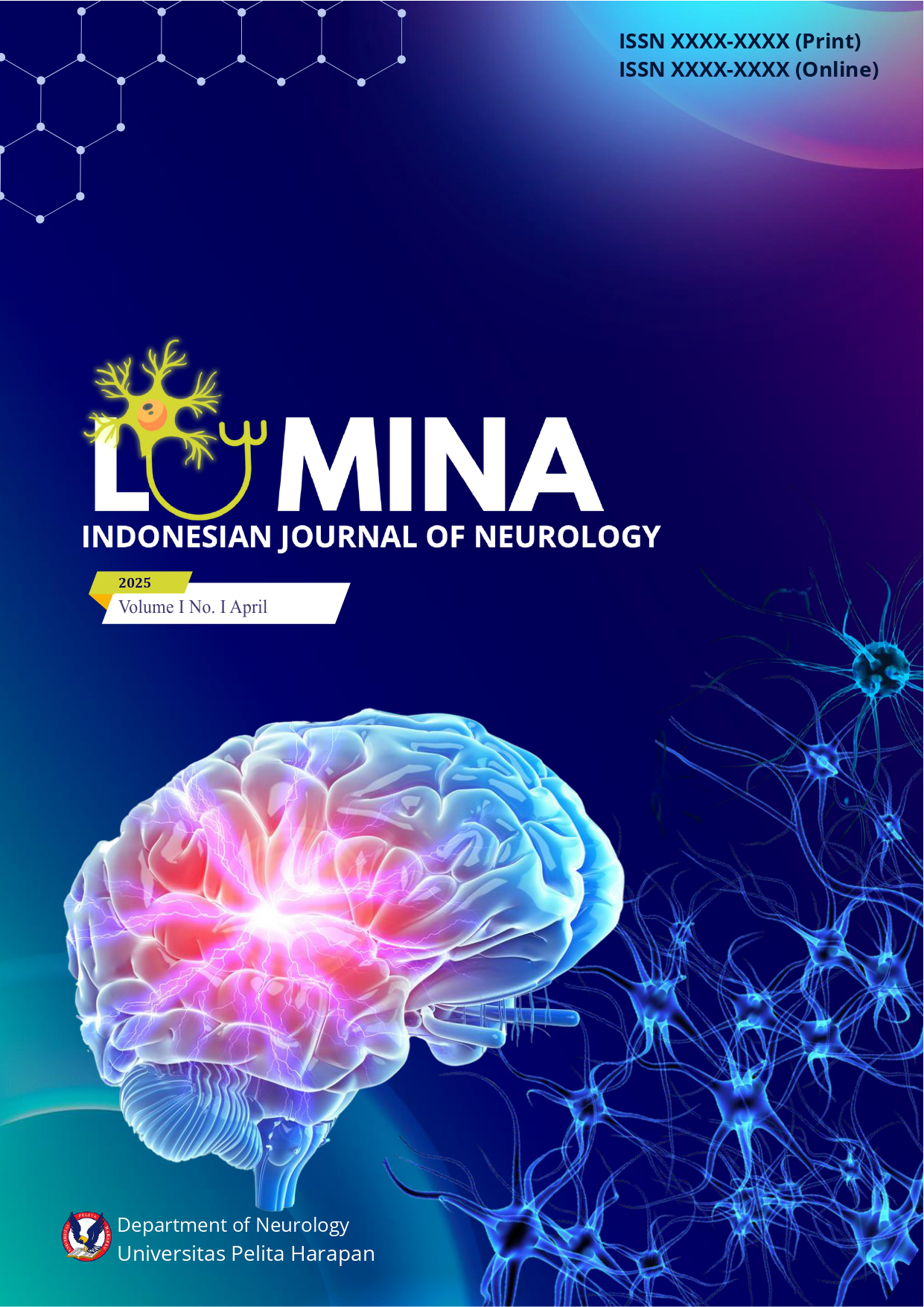Stress-Induced Belly Dancer’s Dyskinesia in A Young Woman: A Rare Case Report
DOI:
https://doi.org/10.19166/lijn.v1i1.9859Keywords:
Dyskinesia, Belly dancer’s dyskinesia, Movement disorderAbstract
Background: Belly dancer’s dyskinesia (BDD) is a movement disorder characterized by involuntary and slow writhing, rhythmic contractions of the abdomen. This rarely encountered phenomenon has not been sufficiently explored, with limited evidence regarding its exact pathophysiology, etiology, and treatment. We present a rare case of stress-induced BDD in a 30-year-old female.
Case summary: A 30-year-old female presented with a 2-month history of involuntary abdominal movements that were sudden in onset, approximately lasting 5-10 minutes, with preserved consciousness. Her symptoms were initially precipitated by stress. However, they worsened within the past week during her menstrual period. Past medical history was significant for long-standing anxiety disorder and depression, for which she took vortioxetine 10mg/day, clonazepam 0.75mg/day, and lorazepam 0.5mg/day routinely. Upon examination, undulating and continuous movements of the abdominal wall were observed. A diagnosis of BDD was made and the patient was treated with an increased dose of clonazepam 1mg/day. Her symptoms significantly improved within three days.
Discussion: Aside from an underlying psychogenic factor, our patient did not have other risk factors for BDD, such as exposure to neuroleptics or history of abdominal trauma. Although certain drugs have been reported to induce BDD, the medications she took have never been reported to cause this condition. Thus, it is most likely that her dyskinesia was stress-induced.
Conclusion: Clinicians may not be familiar with BDD due to its infrequency, and the lack of standardized diagnostic and management strategies makes it challenging to diagnose and treat. Therefore, further research and exposure to BDD are imperative.
References
1. Gupta A, Kushwaha S. Belly dancer’s dyskinesia: A glimpse of a rare phenomenon. Cureus. 2017; 11(9): e1457. https://doi.org/10.7759/cureus.1457
2. Amin OS, Abdulkarim QH, Shaikhani M. Intermittent bursts of abdominal wall jerky movements: Belly Dancer’s syndrome? BMJ Case Reports. 2012: bcr2012007393. https://doi.org/10.1136/bcr-2012-007393
3. Inghilleri M, Conte A, Frasca V, Vaudano AE, Meco G. Belly dance syndrome due to spinal myoclonus. Movement Disorders 2006;21(3):394–396. https://doi.org/10.1002/mds.20698
4. Iliceto G, Thompson PD, Day BL, Rothwell JC, Lees AJ, Marsden CD. Diaphragmatic flutter, the moving umbilicus syndrome, and “belly dancer's”dyskinesia. Movement Disorders. 1990; 5(1):15–22. https://doi.org/10.1002/mds.870050105
5. Castrioto A, Hulliger S, Poon Y-Y, Lang AE, Moro E. A survey on the impact of the menstrual cycle on movement disorders severity. Can J Neurol Sci. 2010; 37(4):478–81. https://doi.org/10.1017/s0317167100010490
6. Rissardo JP, Vora NM, Tariq I, Batra V, Caprara AL. Unraveling belly dancer’s dyskinesia and other puzzling diagnostic contortions: A narrative literature review. Brain Circulation 2024; 10:106–18. https://doi.org/10.4103/bc.bc_110_23
7. Hand R, Snider J, Utt J. Managing functional movement disorder in outpatient physical therapy: a case report of Belly-Dancer Dyskinesia. Movement Disorders. 2020; 35:S546.
8. Linazasoro G, Van Blercom N, Lasa A, Fernández JM, Aranzábal I. Etiological and therapeutical observations in a case of Belly Dancer’s dyskinesia. Movement Disorders. 2005; 20(2):251–253. https://doi.org/10.1002/mds.20312
9. Bane A, Seid AS, Ejeta A, Gorfu ZT. A case report of Belly Dancer Dyskinesia in a 54 years old female: Gastroenterology meets neurology. International Medical Case Reports Journal. 2022; 15:661–3. https://doi.org/10.2147/imcrj.s377843
10. Carecchio M, Collini A, Comi C, Cantello R, Bhatia KP, Monaco F. Levodopa-induced belly dancer's dyskinesias in Parkinson's disease:Report of one case. Movement Disorders. 2010; 25(1):1760–1762. https://doi.org/10.1002/mds.23345
11. Hernández-Fernández F, Pardal-Fernández JM, García-Martínez E, Segura T. Respiratory myoclonus, a side effect of galantamine. Farmacia Hospitalaria. 2011; 35(2):97–9. https://www.revistafarmaciahospitalaria.es/es-respiratory-myoclonus-side-effect-galantamine-articulo-S1130634310002175
12. Leo RJ. Movement disorders associated with the serotonin selective reuptake inhibitors. J Clin Psychiatry. 1996; 57(10):449-454. https://doi.org/10.4088/jcp.v57n1002
13. Gerber PE, Lynd LD. Selective serotonin-reuptake inhibitor–induced movement disorders. Annals of Pharmacotherapy. 1998; 32(6):692–8. https://doi.org/10.1345/aph.17302
14. Goldman JG, Galicia CM. Movement disorders associated with ssris. Movement Disorders in Psychiatry. 2022: 114–C7.P154. http://dx.doi.org/10.1093/med/9780197574317.003.0007
15. Kompoliti K, Comella CL, Jaglin JA, Leurgans S, Raman R, Goetz CG. Menstrual-related changes in motoric function in women with Parkinson’s disease. Neurology. 2000; 55(10):1572-1575. https://doi.org/10.1212/wnl.55.10.1572
16. Gwinn-Hardy KA, Adler CH, Weaver AL, Fish NM, Newman SJ. Effect of hormone variations and other factors on symptom severity in women with dystonia. Mayo Clinic Proceedings. 2000; 75(3):235–40. https://doi.org/10.4065/75.3.235
17. KC D, Kumar Dhakal A, Shrestha D, Acharya S, Neupane N. Abdominal wall dyskinesia in a child presenting as belly dancers’ syndrome: A case report. Journal of Nepal Medical Association. 2023;61(266):831–833. https://doi.org/10.31729/jnma.8296
18. Kono I, Ueda Y, Araki K, Nakajima K, Shibasaki H. Spinal myoclonus resembling belly dance. Movement Disorders. 1994; 9(3):325–9. https://doi.org/10.1002/mds.870090309
19. Tamaya S, Kondo T, Yamabayashi H. Diaphragmatic flutter with a manifestation of high frequency ventilation. Japanese Journal of Medicine. 1983; 22:45–9. https://doi.org/10.2169/internalmedicine1962.22.45
20. Vasconcellos LF, Nassif D, Spitz M. Parkinsonism and belly dancer syndrome in a patient with schizophrenia. Tremor and Other Hyperkinetic Movements. 2019;9. https://doi.org/10.7916/tohm.v0.654
21. Abraham RE, Min GL, Pauzi AL, Salim NH, Ismail I. Acute respiratory failure induced by belly dancer's syndrome:A glance to a rare case report. Turk J Emerg Med. 2023; 23(3):191–194. https://doi.org/10.4103/2452-2473.367398
22. Alshubaili A, Abou-Al-Shaar H, Santhamoorthy P, Attia H, Bohlega S. Ultrasound-guided botulinum toxin A injection in the treatment of belly dancer's dyskinesia. BMC Neurol. 2016; 16(1):226. https://doi.org/10.1186/s12883-016-0746-5
23. Schrader C, Capelle H, Kinfe T, Krauss JK. Pallidal deep brain stimulation in “belly dancer's dyskinesia”. Mov Disord. 2009; 24(11):1698–700. https://doi.org/10.1002/mds.22579
24. Valálik I, Jobbágy Á, Pongrácz F, Szloboda P. Bilateral Gpi-DBS in Belly Dancer's Dyskinesia. Stereotactic and Functional Neurosurgery. 2016; 94 (Suppl. 1): 1–132. https://doi.org/10.1159/000448961





